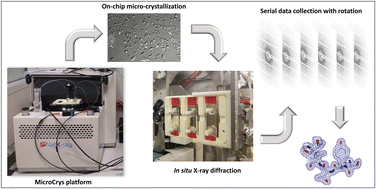Microdialysis on-chip crystallization of soluble and membrane proteins with the MicroCrys platform and in situ X-ray diffraction case studies†
Abstract
This work describes the design and operation of a prototype platform (MicroCrys) developed to automate the on-chip dialysis crystallization of proteins via chemical composition and temperature control, facilitating the optimization of crystallization conditions and the exploration of protein phase diagrams. A custom-built computer software (LabVIEW) displaying a user-friendly graphical interface has been designed to manipulate all the separate functionalities of the MicroCrys platform. These include visualization and recording, fluidic components for mixing, circulating and dynamically exchanging the crystallization solutions in the dialysis chip and a customized metallic support for thermal regulation via the Peltier effect. Two model soluble proteins, hen egg white lysozyme (HEWL) and thaumatin from Thaumatococcus daniellii, were used to exemplify the competence of MicroCrys for growing high-quality protein crystals for in situ X-ray diffraction experiments at room temperature. HEWL was also used to validate the compatibility of the dialysis chips with the lipid cubic phase (LCP) crystallization method and the microcrystals were used for room temperature in situ synchrotron serial X-ray crystallography (SSX). Finally, SERCA (sarco/endoplasmic reticulum Ca2+-ATPase) from Oryctolagus cuniculus has been used as a case study to demonstrate the feasibility of on-chip microdialysis crystallization of membrane proteins.

- This article is part of the themed collection: Biomolecular crystal engineering


 Please wait while we load your content...
Please wait while we load your content...